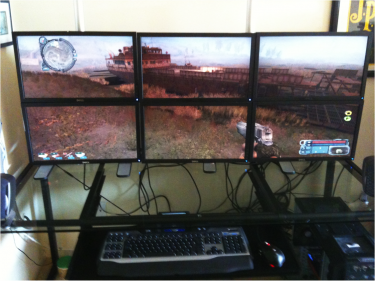AMD has introduced their latest FirePro workstation product, the V9800. The V9800 includes AMD’s Eyefinity technology that enables up to six independent displays. With this board, AMD is pledging allegiance to OpenCL.
AMD’s was first in with support for Direct X 11 and they’re hoping that edge has paid off. Direct X 11 brings hardware accelerated tessellation to smooth models while reducing their complexity, multithreading to take advantage of multiple processors, and DirectCompute. The DirectCompute environment that’s part of DirectX enables developers to program to the GPU and the CPU. AMD has a short lead time but the company intends to make the most of it.

In order to achieve Eyefinity, ATI’s new FirePro boards sport six Mini DisplayPort outputs and requires Windows 7, Windows Vista or Linux for more than 2 displays.
The V9800 is the newest member of the ATI FirePro family, which also includes the ATI FirePro V8800, V7800, V5800, V4800 and V3800 WS-AIBs.
Onboard GPU memory is a major enabler for advanced visualization and AMD has focused on this area for the V9800. The $3,499 Workstation AIB has 4 GB of GDDR5 memory and can provide an expansive desktop resolution of up to 5760 x 2160 to enable more multitasking and improve visualization applications. Single monitor support is 2560 x 1600 at 60 Hz. In addition, it supports 30-bit color for wide gamut displays.
ATI claims the ATI FirePro V9800 features significant performance increases over the previous generation of FirePro products, including 1.25x increased compute stream processor performance, and an increase of 2.27x in single- and double-precision performance. AMD says the ATI FirePro V9800, powered by its 1,600 stream processors – the industry’s highest number – is optimized for stream calculations with full support for OpenCL, DirectCompute, DirectX 11, and OpenGL 4.0.
Like the other products in the ATI FirePro family, the ATI FirePro V9800 offers support for stereo 3D capability, supporting active shutter glasses via the on-board 3-pin connector, as well as passive and auto-stereoscopic displays and projectors. Additionally, with support for the ATI FirePro S400 synchronization module, up to four ATI FirePro V9800 graphics cards can be synchronized (genlock, framelock), delivering up to 24 synchronized outputs from a single computer. The primary applications here are for large dataset visualizations for powerwalls and video wall applications.
What do we think?
AMD is taking aim on the workstation market and intends to regain lost ground. The company believes that its Eyefinity multi-monitor technology is going to cause even dedicated Nvidia-philes to take a look and is banking on its strategy of openness to give it a boost. For instance, AMD’s says their stereographic 3D technology will work with a variety of systems and 120/240 Hz monitors. In other words, they’re not promoting a proprietary solution like Nvidia does. Rather they’ll work with vendors to create a system and so there may be different options for glasses and monitors. (There is argument, of course, that this approach further confuses the situation.) However, we do think that desktop S3D, which Nvidia helped pioneer with its proprietary glasses and board products and is now being taken up by AMD under the banner of openness, is going to advance the field of visualization by giving users easily accessible options.
AMD is also banking on DirectX 11 DirectCompute and OpenCL. DirectCompute is an open technology as long as you’re on Windows and OpenCL competes with Nvidia’s CUDA as an open technology to provide access to GPU processors. Nvidia and AMD support these technologies because vendors are looking for cross-platform tools and that includes Nvidia and AMD and Apple/Windows/Linux.
2010 and 2011 are going to be heady years for GPU Compute and by that we really mean heterogeneous systems employing both CPUs and GPUs because that is how the world is going to roll.





